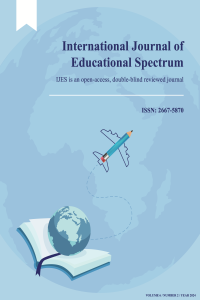Öz
Kaynakça
- Abasıyanık, S. F. (2008). Dülger Balığının Ölümü. İstanbul: Türkiye İş Bankası Kültür Yayınları.
- Atkinson, R. C. (1975). Mnemonics in second-language learning. American Psychologist, 30(11), 821-828.
- Buzan, T. (2010). The Mind Map Book: Unlock your Creativity, Boost your Memory, Change your Life. BBC Active.
- Creswell, J. W. (2013). Qualitative Inquiry and Research Design: Choosing Among Five Approaches (3rd ed.). SAGE Publications.
- Denzin, N. K., & Lincoln, Y. S. (2018). The SAGE Handbook of Qualitative Research. SAGE Publications.
- Erdoğan, İ. (2012). Türkçe Dersinde Metin Türleri ve Analiz Yöntemleri. Ankara: Anı Yayıncılık.
- Fidan, N. K. (2011). Zihin Haritalama ve Eğitimde Kullanımı. Ankara: Pegem Akademi Yayıncılık.
- Güneş, F. (2015). Öyküleyici Metinlerin Okunması ve Analizi. Ankara: Nobel Akademik Yayıncılık.
- Higbee, K. L. (2001). Your Memory: How It Works and How to Improve It. Da Capo Lifelong Books.
- Lorayne, H., & Lucas, J. (1996). The Memory Book: The Classic Guide to Improving Your Memory at Work, at School, and at Play. Ballantine Books.
- Paivio, A. (1971). Imagery and Verbal Processes. Holt, Rinehart, and Winston.
- Patton, M. Q. (2015). Qualitative Research & Evaluation Methods (4th ed.). SAGE Publications.
- Merriam, S. B., & Tisdell, E. J. (2015). Qualitative Research: A Guide to Design and Implementation (4th ed.). Jossey-Bass.
- Yates, F. A. (1966). The Art of Memory. University of Chicago Press.
- Yazıcı, K. (2006). Hikâye edici metinlerin çözümlenmesinde hikâyenin yüzey stratejisinin kullanılması. 299-241.
- Yıldırım, A., & Şimşek, H. (2016). Sosyal Bilimlerde Nitel Araştırma Yöntemleri (10. Baskı). Seçkin Yayıncılık.
Öz
This paper discusses how the Memory Pegged Mind Mapping (MPMM) method can be utilized for the analysis of narrative texts. Content analysis, a part of qualitative research methods, systematically examines meanings and themes within texts. Narrative texts serve as significant tools for individuals to convey experiences and emotions, offering rich and layered meanings through their analysis. The MPMM method is a technique that aids researchers in organizing and visualizing information and ideas, helping them retain key points effectively. It contributes to the systematic identification of themes and motifs in narrative texts. The article emphasizes the importance of narrative texts within the context of Turkish language courses and details the application of the MPMM method for their analysis. Additionally, it explains how fundamental elements of narrative texts can be analyzed by integrating mind mapping and memory peg techniques. The analyses conducted using MPMM are expected to enhance students' deeper understanding of texts and foster their critical thinking skills. This method can effectively serve as a tool to improve students' reading and writing abilities, offering innovative approaches in education. In conclusion, the use of MPMM in narrative text analysis enriches qualitative research methods and facilitates a deeper understanding of narrative texts. This paper aims to provide a comprehensive perspective on the application of MPMM in education and research, contributing to academic studies and teaching processes.
Anahtar Kelimeler
Kaynakça
- Abasıyanık, S. F. (2008). Dülger Balığının Ölümü. İstanbul: Türkiye İş Bankası Kültür Yayınları.
- Atkinson, R. C. (1975). Mnemonics in second-language learning. American Psychologist, 30(11), 821-828.
- Buzan, T. (2010). The Mind Map Book: Unlock your Creativity, Boost your Memory, Change your Life. BBC Active.
- Creswell, J. W. (2013). Qualitative Inquiry and Research Design: Choosing Among Five Approaches (3rd ed.). SAGE Publications.
- Denzin, N. K., & Lincoln, Y. S. (2018). The SAGE Handbook of Qualitative Research. SAGE Publications.
- Erdoğan, İ. (2012). Türkçe Dersinde Metin Türleri ve Analiz Yöntemleri. Ankara: Anı Yayıncılık.
- Fidan, N. K. (2011). Zihin Haritalama ve Eğitimde Kullanımı. Ankara: Pegem Akademi Yayıncılık.
- Güneş, F. (2015). Öyküleyici Metinlerin Okunması ve Analizi. Ankara: Nobel Akademik Yayıncılık.
- Higbee, K. L. (2001). Your Memory: How It Works and How to Improve It. Da Capo Lifelong Books.
- Lorayne, H., & Lucas, J. (1996). The Memory Book: The Classic Guide to Improving Your Memory at Work, at School, and at Play. Ballantine Books.
- Paivio, A. (1971). Imagery and Verbal Processes. Holt, Rinehart, and Winston.
- Patton, M. Q. (2015). Qualitative Research & Evaluation Methods (4th ed.). SAGE Publications.
- Merriam, S. B., & Tisdell, E. J. (2015). Qualitative Research: A Guide to Design and Implementation (4th ed.). Jossey-Bass.
- Yates, F. A. (1966). The Art of Memory. University of Chicago Press.
- Yazıcı, K. (2006). Hikâye edici metinlerin çözümlenmesinde hikâyenin yüzey stratejisinin kullanılması. 299-241.
- Yıldırım, A., & Şimşek, H. (2016). Sosyal Bilimlerde Nitel Araştırma Yöntemleri (10. Baskı). Seçkin Yayıncılık.
Ayrıntılar
| Birincil Dil | İngilizce |
|---|---|
| Konular | Eğitim Üzerine Çalışmalar (Diğer) |
| Bölüm | Araştırma Makaleleri |
| Yazarlar | |
| Erken Görünüm Tarihi | 24 Eylül 2024 |
| Yayımlanma Tarihi | 24 Eylül 2024 |
| Gönderilme Tarihi | 10 Temmuz 2024 |
| Kabul Tarihi | 22 Eylül 2024 |
| Yayımlandığı Sayı | Yıl 2024 Cilt: 6 Sayı: 2 |
ISSN: 2667-5870


